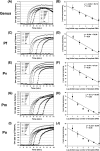Detection of four Plasmodium species by genus- and species-specific loop-mediated isothermal amplification for clinical diagnosis
- PMID: 17567794
- PMCID: PMC1951264
- DOI: 10.1128/JCM.02117-06
Detection of four Plasmodium species by genus- and species-specific loop-mediated isothermal amplification for clinical diagnosis
Abstract
Loop-mediated isothermal amplification (LAMP), a novel nucleic acid amplification method, was developed for the clinical detection of four species of human malaria parasites: Plasmodium falciparum, P. vivax, P. malariae, and P. ovale. We evaluated the sensitivity and specificity of LAMP in comparison with the results of microscopic examination and nested PCR. LAMP showed a detection limit (analytical sensitivity) of 10 copies of the target 18S rRNA genes for P. malariae and P. ovale and 100 copies for the genus Plasmodium, P. falciparum, and P. vivax. LAMP detected malaria parasites in 67 of 68 microscopically positive blood samples (sensitivity, 98.5%) and 3 of 53 microscopically negative samples (specificity, 94.3%), in good agreement with the results of nested PCR. The LAMP reactions yielded results within about 26 min, on average, for detection of the genus Plasmodium, 32 min for P. falciparum, 31 min for P. vivax, 35 min for P. malariae, and 36 min for P. ovale. Accordingly, in comparison to the results obtained by microscopy, LAMP had a similar sensitivity and a greater specificity and LAMP yielded results similar to those of nested PCR in a shorter turnaround time. Because it can be performed with a simple technology, i.e., with heat-treated blood as the template, reaction in a water bath, and inspection of the results by the naked eye because of the use of a fluorescent dye, LAMP may provide a simple and reliable test for routine screening for malaria parasites in both clinical laboratories and malaria clinics in areas where malaria is endemic.
Figures



References
-
- Coleman, R. E., J. Sattabongkot, S. Promstaporm, N. Maneechai, B. Tippayachai, A. Kengluecha, N. Rachapaew, G. Zollner, R. S. Miller, J. A. Vaughan, K. Thimasarn, and B. Khuntirat. 2006. Comparison of PCR and microscopy for the detection of asymptomatic malaria in a Plasmodium falciparum/vivax endemic area in Thailand. Malar. J. 14:121. - PMC - PubMed
-
- Ferro, B. E., I. J. Gonzalez, F. Carvajal, G. I. Palma, and N. G. Saravia. 2002. Performance of OptiMAL in the diagnosis of Plasmodium vivax and Plasmodium falciparum infections in a malaria referral center in Colombia. Mem. Inst. Oswaldo Cruz 97:731-735. - PubMed
-
- Hanscheid, T., and M. P. Grobusch. 2002. How useful is PCR in the diagnosis of malaria? Trends Parasitol. 18:395-398. - PubMed
-
- Ikadai, H., H. Tanaka, N. Shibahara, A. Matsuu, M. Uechi, N. Itoh, S. Oshiro, N. Kudo, I. Igarashi, and T. Oyamada. 2004. Molecular evidence of infections with Babesia gibsoni parasites in Japan and evaluation of the diagnostic potential of a loop-mediated isothermal amplification method. J. Clin. Microbiol. 42:2465-2469. - PMC - PubMed
Publication types
MeSH terms
Substances
LinkOut - more resources
Full Text Sources
Other Literature Sources
Medical

